module 15 How Evolution Creates Biodiversity
We have seen the importance of biodiversity. In this module we will look at the processes of evolution, which is the source of biodiversity. Because the evolution of biodiversity depends on genetic diversity, we will examine how genetic diversity is created. We begin by exploring the sources of genetic variation and then consider how humans and the natural world select from this variation to favor particular individuals that go on to reproduce in the next generation. Finally, we will examine how several random processes can also cause evolution.
Learning Objectives
After reading this module you should be able to
identify the processes that cause genetic diversity.
explain how evolution can occur through artificial selection.
explain how evolution can occur through natural selection.
explain how evolution can occur through random processes.
Genetic diversity is created through mutation and recombination
Evolution A change in the genetic composition of a population over time.
Microevolution Evolution below the species level.
Macroevolution Evolution that gives rise to new species, genera, families, classes, or phyla.
Earth’s biodiversity is the product of evolution, which can be defined as a change in the genetic composition of a population over time. Evolution can occur at multiple levels. Evolution below the species level, such as the evolution of different varieties of apples or potatoes, is called microevolution. In contrast, when genetic changes give rise to new species, or to new genera, families, classes, or phyla—
Gene A physical location on the chromosomes within each cell of an organism.
Genotype The complete set of genes in an individual.
To understand how genetic diversity is created, we first need to understand genes. Genes are physical locations on chromosomes within each cell of an organism. A given gene has DNA that codes for a particular trait, such as body size, but the DNA can take different forms known as alleles. An organism’s genes determine the range of possible traits (physical or behavioral characteristics) that it can pass down to its offspring. The complete set of genes in an individual is called its genotype. In this section, we will discuss how genotypes help to determine the traits of individuals and the two processes that can create genetic diversity in a population: mutation and recombination.
Genotypes versus Phenotypes
Phenotype A set of traits expressed by an individual.
An individual’s genotype serves as the blueprint for the complete set of traits that organism may potentially possess. An individual’s phenotype is the actual set of traits expressed in that individual. Among these traits are the individual’s anatomy, physiology, and behavior. The color of your eyes, for example, is your phenotype, whereas the genes that code for eye color are a part of your genotype. Changes in genotypes can produce important changes in phenotypes.
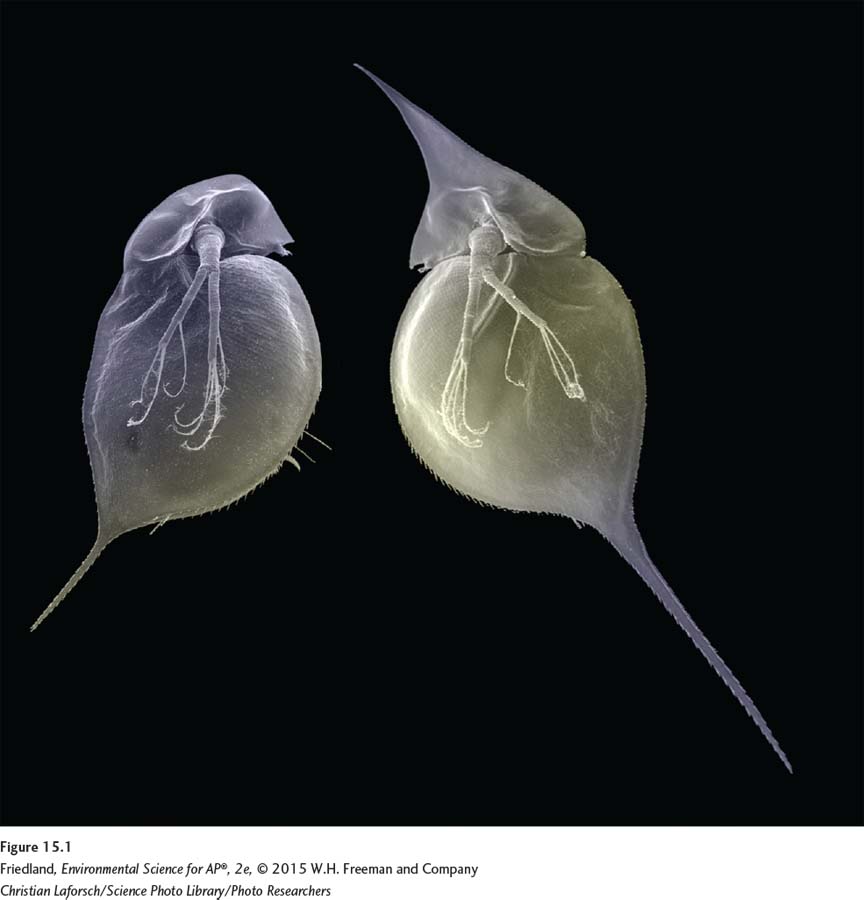
In some cases, an individual’s phenotype is determined almost entirely by genes. For instance, a person who inherits the genes for brown eyes will have brown eyes, regardless of where that person lives. Most phenotypes, however, are the product of an individual’s environment as well as its genotype. For example, in many turtle and crocodile species, the temperature of eggs during incubation determines whether the offspring will hatch as males or females. The water flea, a tiny animal that lives in ponds and lakes, offers another interesting example. The body shape of the water flea depends on whether or not a young individual smells predators in its environment (FIGURE 15.1). If predators are absent, the water flea develops a relatively small head and tail spine. If predators are present, however, the water flea develops a much larger head and a long tail spine. Although the larger head and longer tail spine help prevent the water flea from being eaten, they come at the cost of slower reproduction. Therefore, it is beneficial that the water flea not produce these defenses unless they are needed. By being able to respond to changing environmental conditions, organisms such as the water flea can improve their ability to survive and reproduce in any environment.
Mutation
Mutation A random change in the genetic code produced by a mistake in the copying process.
DNA is copied millions of times during an organism’s lifetime as cells grow and divide. An occasional mistake in the copying process produces a random change in the genetic code, which is known as a mutation. Environmental factors, such as ultraviolet radiation from the Sun, can also cause mutations. When mutations occur in cells responsible for reproduction, such as the eggs and sperm of animals, those mutations can be passed on to the next generation.
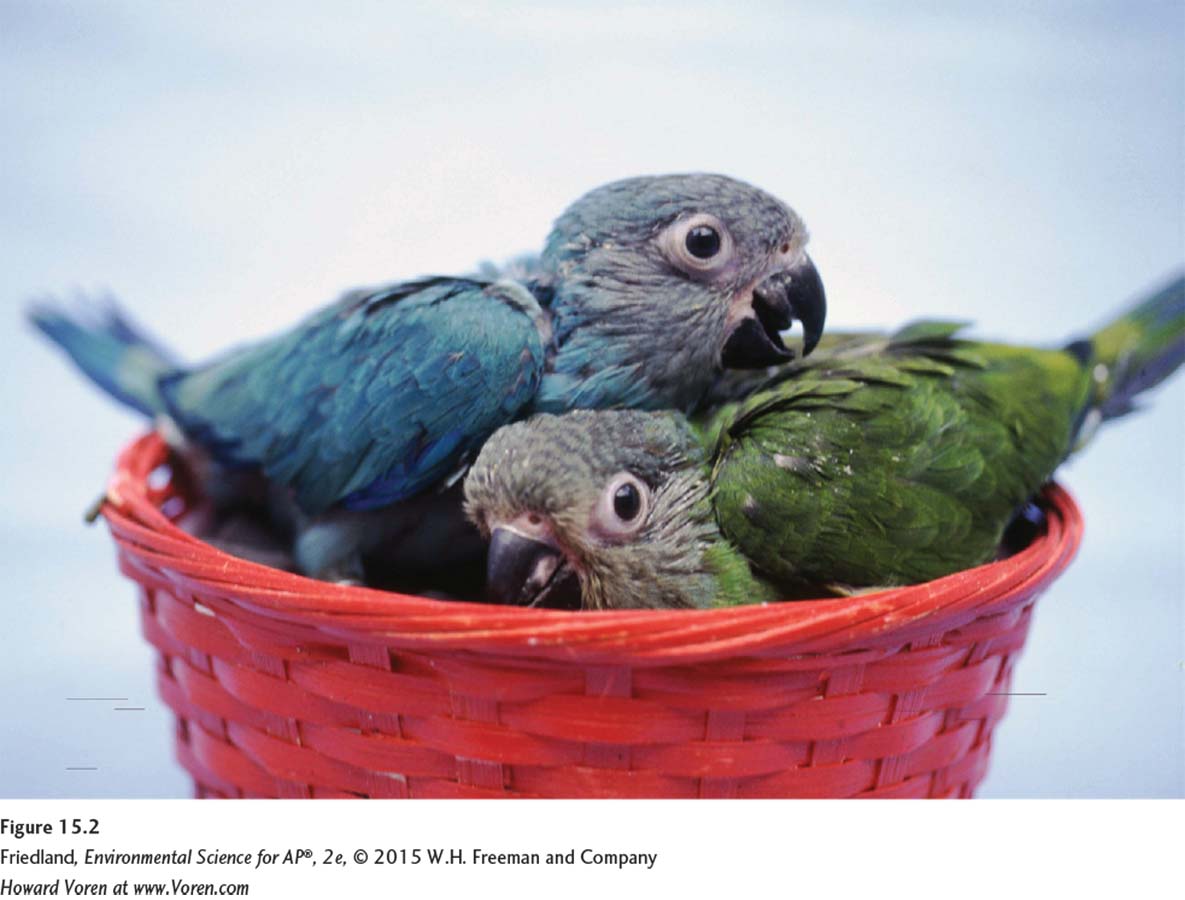
Most mutations are detrimental, and many cause the offspring that carry them to die while they are embryos. The effects of some mutations are less severe, but can still be detrimental. For example, some dusky-
Sometimes a mutation improves an organism’s chances of survival or reproduction. If such a mutation is passed along to the next generation, it adds new genetic diversity to the population. Some mosquitoes, for example, possess a mutation that makes them less vulnerable to insecticides. In areas that are sprayed with insecticides, this mutation improves an individual mosquito’s chance of surviving and reproducing.
Recombination
Recombination The genetic process by which one chromosome breaks off and attaches to another chromosome during reproductive cell division.
Genetic diversity can also be created through recombination. In plants and animals, genetic recombination occurs as chromosomes are duplicated during reproductive cell division and a piece of one chromosome breaks off and attaches to another chromosome. This process does not create new genes, but it does bring together new combinations of alleles on a chromosome and can therefore produce novel traits. For example, the human immune system must battle a large variety of viruses and bacteria that regularly attempt to invade the body. Recombination allows new allele combinations to come together, and this provides new immune defenses that may prove to be effective against the invading organisms.
Evolution can occur through artificial selection
Evolution occurs in three primary ways: artificial selection, natural selection, and random processes. In this section we will look at artificial selection.
Humans have long influenced evolution by breeding plants and animals for desirable traits. For example, all breeds of domesticated dogs belong to the same species as the gray wolf (Canis lupus), yet dogs exist in an amazing variety of sizes and shapes, ranging from toy poodles to Siberian huskies. FIGURE 15.3 shows the phylogenetic relationships among the wolf and different breeds of domestic dogs that were bred from the wolf by humans. Beginning with the domestication of wolves, dog breeders have selectively bred individuals that had particular qualities they desired, including body size, body shape, and coat color. After many generations of breeding, the selected traits became more and more exaggerated until breeders felt satisfied that the desired characteristics of a new dog breed had been achieved. As a result of this carefully controlled breeding, we have a tremendous variety of dog sizes, shapes, and colors today. Yet dogs remain a single species: All dog breeds can still mate with one another and produce viable offspring.
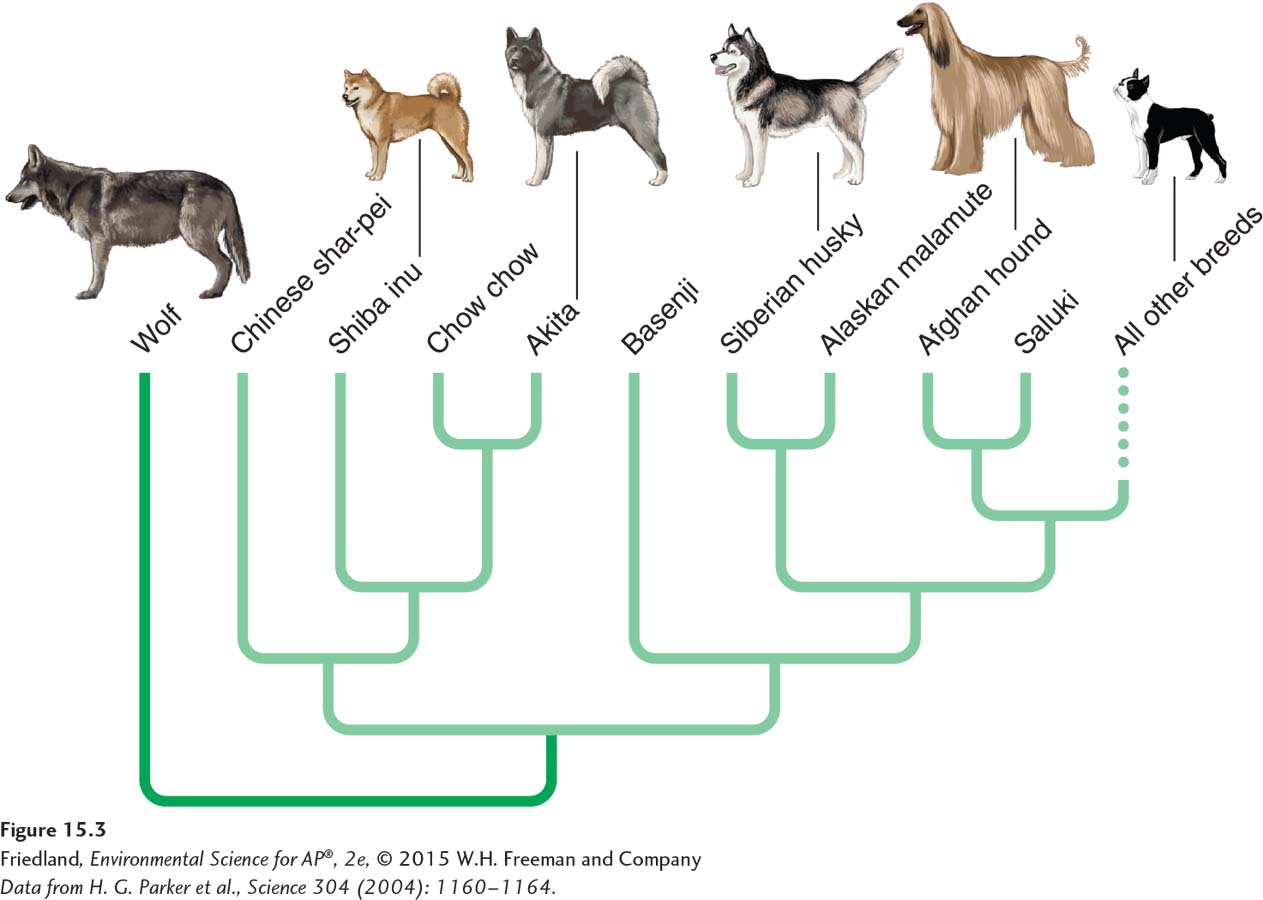
Evolution by artificial selection The process in which humans determine which individuals breed, typically with a preconceived set of traits in mind.
When humans determine which individuals to breed, typically with a preconceived set of traits in mind, we call the process evolution by artificial selection. Artificial selection has produced numerous breeds of horses, cattle, sheep, pigs, and chickens with traits that humans find useful or aesthetically pleasing. Most of our modern agricultural crops are also the result of many years of careful breeding. For example, starting with a single species of wild mustard, Brassica oleracea, plant breeders have produced a variety of food crops, including cabbage, cauliflower, broccoli, Brussels sprouts, kale, and kohlrabi, shown in FIGURE 15.4.

As useful as artificial selection has been to humans, it can also produce a number of unintended results. For example, farmers often use herbicides to kill weeds. However, as we cover larger and larger areas with herbicides, there is an increasing chance that at least one weed will possess a mutation that allows it to survive the herbicide application. If that one mutant plant passes on its herbicide resistance to its offspring, we will have artificially selected for herbicide resistance in that weed. This process is occurring in many parts of the world where increased use of the popular herbicide Roundup (chemical name: glyphosate) has led to the evolution of several species of Roundup-
Evolution can occur through natural selection
Evolution by natural selection The process in which the environment determines which individuals survive and reproduce.
Evolution also takes place through natural mechanisms. In evolution by natural selection, the environment determines which individuals survive and reproduce. Members of a population naturally vary in their traits, and certain combinations of those traits make individuals better able to survive and reproduce. As a result, the genes that produce those traits are more common in the next generation.
Prior to the mid-
Of the two scientists, Charles Darwin is perhaps the better known. At age 22, he became the naturalist on board HMS Beagle, a British survey ship that sailed around the world from 1831 to 1836. During his journey, Darwin made many observations of trait variation across a tremendous variety of species. In addition to observing living organisms, he found fossil evidence of a large number of extinct species. He also recognized that organisms produce many more offspring than are needed to replace the parents, and that most of these offspring do not survive. Darwin questioned why, out of all the species that had once existed on Earth, only a small fraction had survived. Similarly, he wondered why, among all the offspring produced in a population in a given year, only a small fraction survived to the next year. During the decades following his voyage, he developed his ideas into a robust theory. His On the Origin of Species by Means of Natural Selection, published in 1859, changed the way people thought about the natural world.
The key ideas of Darwin’s theory of evolution by natural selection are the following:
Individuals produce an excess of offspring.
Not all offspring can survive.
Individuals differ in their traits.
Differences in traits can be passed on from parents to offspring.
Differences in traits are associated with differences in the ability to survive and reproduce.
FIGURE 15.5 shows how this process works using the example of body size in a group of crustaceans known as amphipods. We can begin with parents producing offspring that vary in their body size. The largest offspring are consumed by fish because fish prefer to eat large prey rather than small prey. As a result, the smaller offspring are left to reproduce. Because body size is, in part, determined by an individual’s genes, the next generation of amphipods will be smaller. This process can continue over many generations and over time the fish will cause the evolution of smaller body sizes in amphipods.

Fitness An individual’s ability to survive and reproduce.
Adaptation A trait that improves an individual’s fitness.
Both artificial and natural selection begin with the requirement that individuals vary in their traits and that these variations are capable of being passed on to the next generation. In both cases, parents produce more offspring than necessary to replace themselves, and some of these offspring either do not survive or do not reproduce. But in the case of artificial selection, humans decide which individuals will breed, based on those individuals that possess the traits that tend toward some predetermined goal, such as a curly coat or large size. Natural selection does not select for specific traits that tend toward some predetermined goal. Rather, natural selection favors any combination of traits that improves an individual’s fitness—its ability to survive and reproduce, as we saw in the case of the smallest amphipods surviving predation by fish. Traits that improve an individual’s fitness are called adaptations.
Natural selection can favor multiple solutions to a particular environmental challenge, as long as each solution improves an individual’s ability to survive and reproduce. For example, while all plants living in the desert face the challenge of low water availability in the soil, different species have evolved different solutions to this common challenge. Some species have evolved large taproots to draw water from deep in the soil. Other species have evolved the ability to store excess water during infrequent rains. Still other species have evolved waxy or hairy leaf surfaces that reduce water loss. Each of these very different adaptations allows the plants to survive and reproduce in a desert environment (FIGURE 15.6).
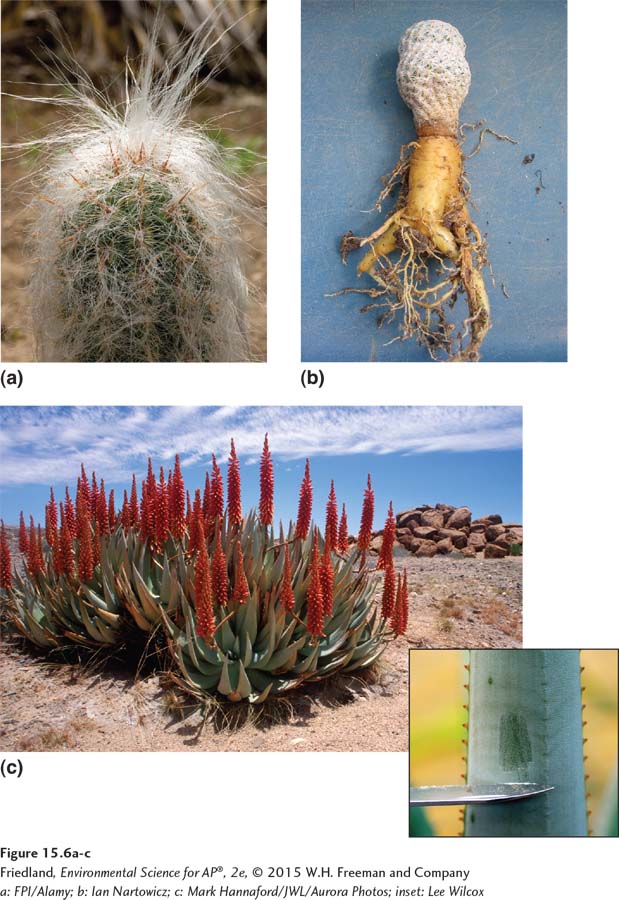
Evolution can also occur through random processes
Artificial and natural selection are important mechanisms of evolution, but evolution can also occur by random, or nonadaptive, processes. In these cases, the genetic composition of a population changes over time, but the changes are not related to differences in fitness among individuals. There are five random processes: mutation, gene flow, genetic drift, bottleneck effects, and founder effects.
Mutation
If a random mutation is not lethal, it can add to the genetic variation of a population. As shown in FIGURE 15.7, the larger the population, the more opportunities there will be for mutations to appear within it. As the number of mutations accumulates in the population over time, evolution occurs.
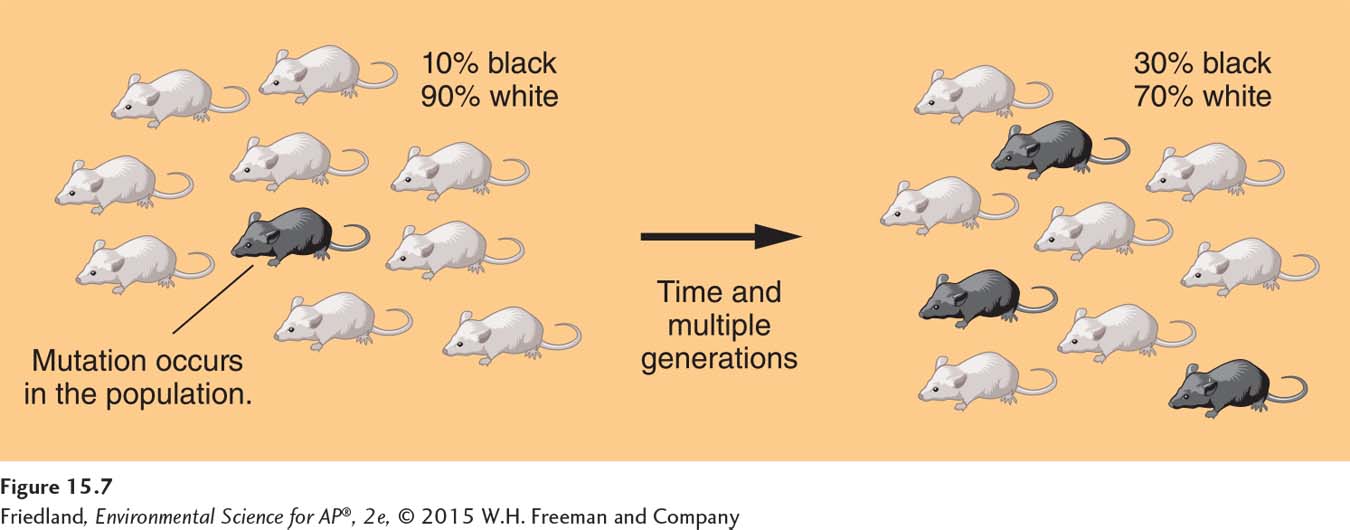
Gene flow
Gene flow The process by which individuals move from one population to another and thereby alter the genetic composition of both populations.
Gene flow is the process by which individuals move from one population to another and thereby alter the genetic composition of both populations. Populations can experience an influx of migrating individuals with different alleles. The arrival of these individuals from adjacent populations alters the frequency of alleles in the population. High gene flow between two populations can cause the two populations to become very similar in genetic composition. In a population that is experiencing natural or artificial selection, high gene flow from outside can prevent the population from responding to selection.
Gene flow can be helpful in bringing in genetic variation to a population that lacks it. For example, the Florida panther is a subspecies of panther that once roamed throughout much of the southeastern United States and likely experienced gene flow with other subspecies of panthers. By 1995, the Florida panther only lived in southern Florida, occupying only 5 percent of its original habitat. Moreover, the number of panthers declined to only about 30 individuals, and because the Florida subspecies was isolated from other subspecies, it did not experience gene flow. As a result, shown in FIGURE 15.8, the small population had low genetic variation and the remaining individuals became very inbred. Being inbred causes individuals to express homozygous, harmful alleles. In the case of the panthers, these deleterious alleles caused a high prevalence of kinked tails, heart defects, and low sperm counts. In response, the U.S. Fish and Wildlife Service captured eight panthers from the Texas subspecies and introduced them to Florida with the hope that this gene flow would increase the genetic variation and allow the population to grow. By 2011, the prevalence of defects previously seen from inbreeding had declined and the Florida panther population had increased to 160 individuals.
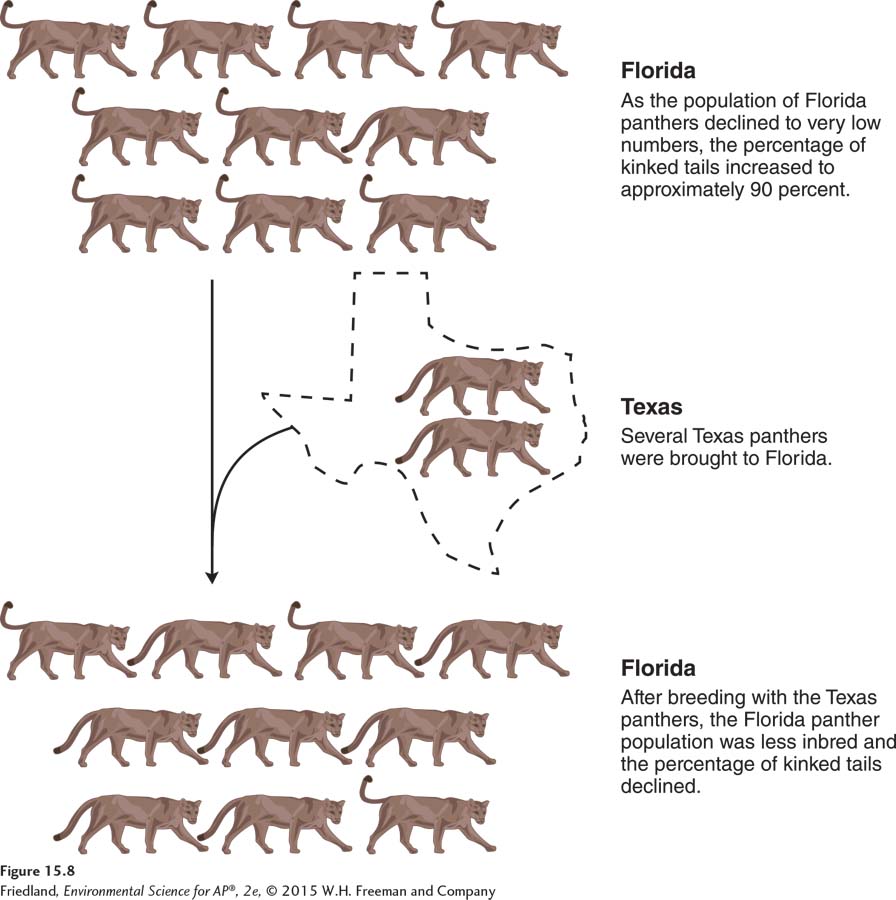
Genetic Drift
Genetic drift A change in the genetic composition of a population over time as a result of random mating.
Genetic drift is a change in the genetic composition of a population over time as a result of random mating. Like mutation and gene flow, genetic drift is a nonadaptive, random process. It can have a particularly important role in altering the genetic composition of small populations, as illustrated in FIGURE 15.9. In small populations, shown in FIGURE 15.9a, random mating among individuals can eliminate some of the rare individuals simply because they did not find a mate in a given year. For example, imagine a small population of five animals, in which two individuals carry genes that produce black hair and three individuals carry genes that produce white hair. If, by chance, the individuals that carry the genes for black hair fail to find a mate, those genes will not be passed on. The next generation will be entirely white-
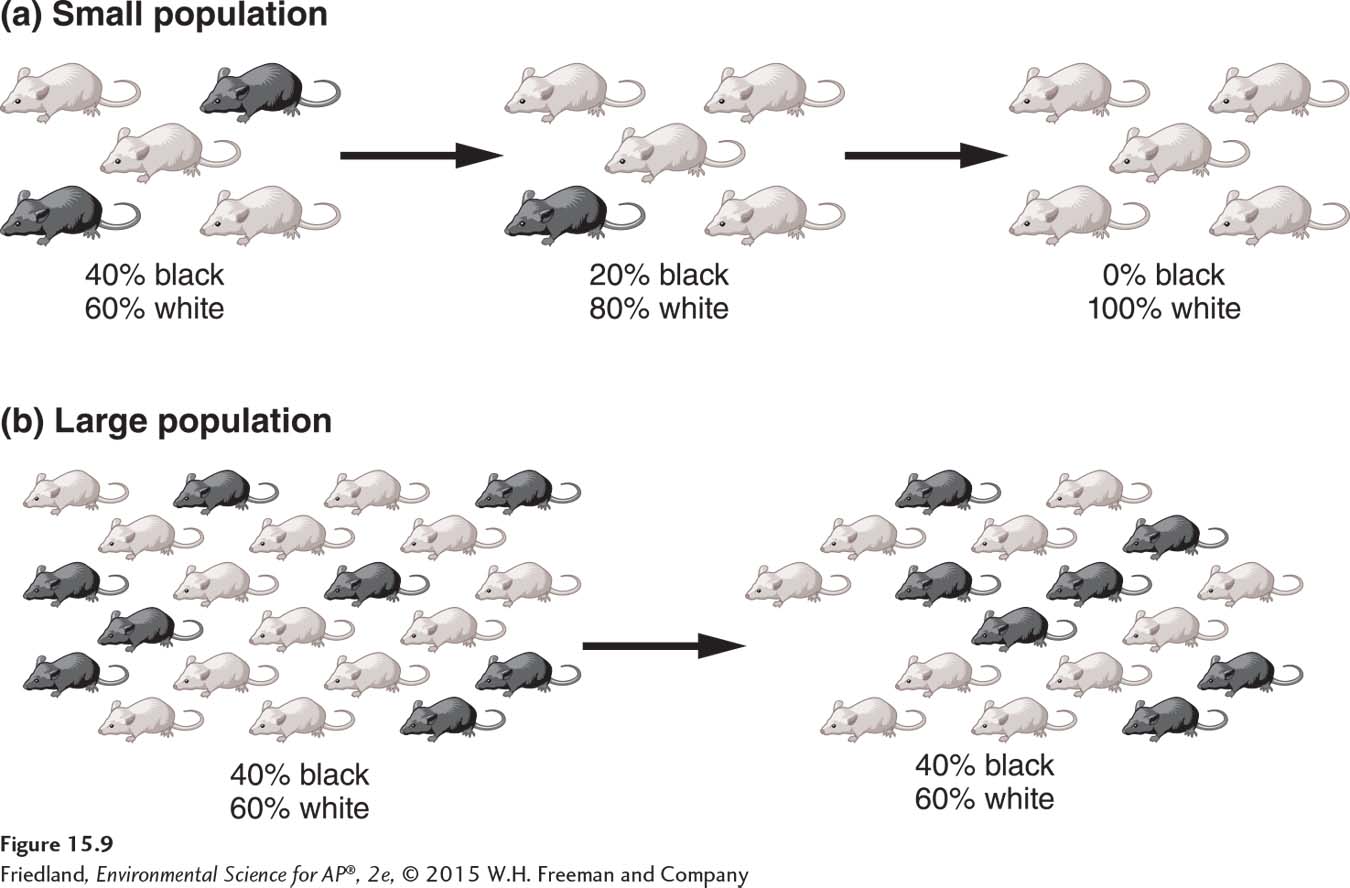
Bottleneck Effect
Bottleneck effect A reduction in the genetic diversity of a population caused by a reduction in its size.
A drastic reduction in the size of a population that reduces genetic variation—
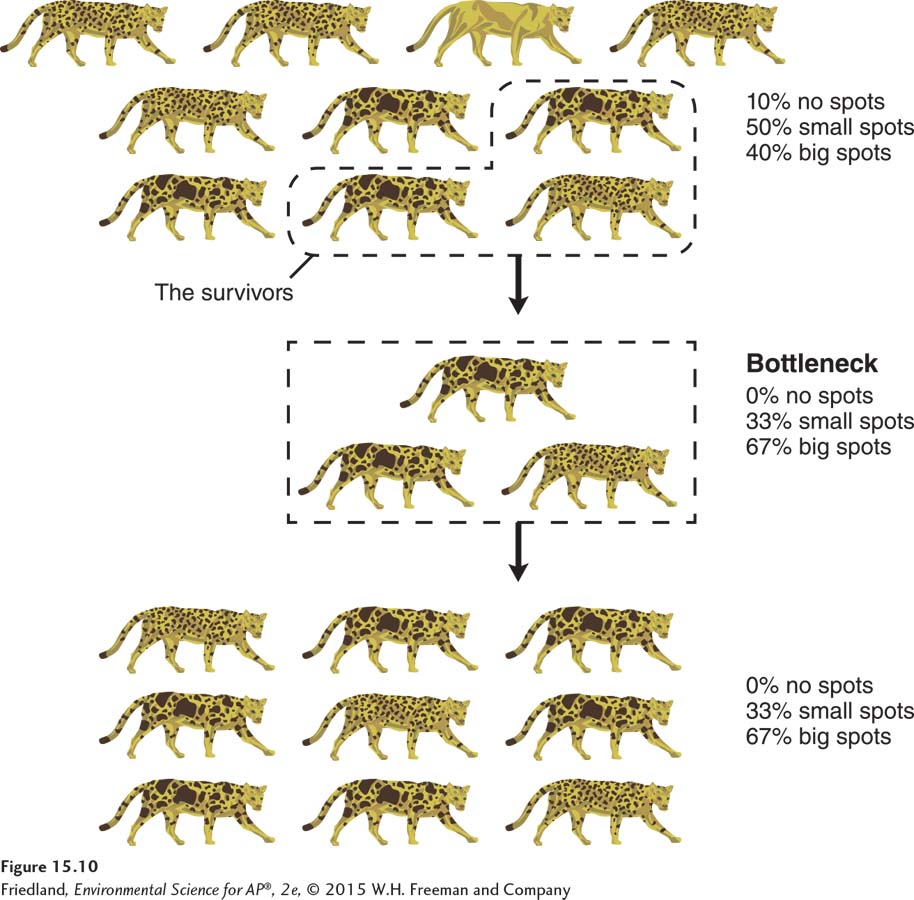
Extinction The death of the last member of a species.
Low genetic variation in a population can cause several problems, including increased risk of disease and low fertility. In addition, species that have been through a population bottleneck are often less able to adapt to future changes in their environment. In some cases, once a species has been forced through a bottleneck, the resulting low genetic diversity causes it to decline to extinction, which occurs when the last member of a species dies. Such declines are thought to be occurring in a number of species today. The cheetah, for example, has relatively little genetic variation due to a bottleneck that appears to have occurred 10,000 years ago.

Founder Effect
Founder effect A change in the genetic composition of a population as a result of descending from a small number of colonizing individuals.
Imagine that a few individuals of a particular bird species happen to be blown off their usual migration route and land on a hospitable oceanic island, as illustrated in FIGURE 15.11. These two individuals will have been drawn at random from the mainland population, and the genotypes they possess are only a subset of those in the original mainland population. These colonizing individuals, or founders, will give rise to an island population that has a genetic composition very different from that of the original mainland population. A change in the genetic composition of a population as a result of descending from a small number of colonizing individuals is known as the founder effect. Like mutation, genetic drift, and the bottleneck effect, the founder effect is a random process that is not based on differences in fitness.
We can see an example of the founder effect in the Amish communities of Pennsylvania. The Amish population was founded by a relatively small number of individuals—